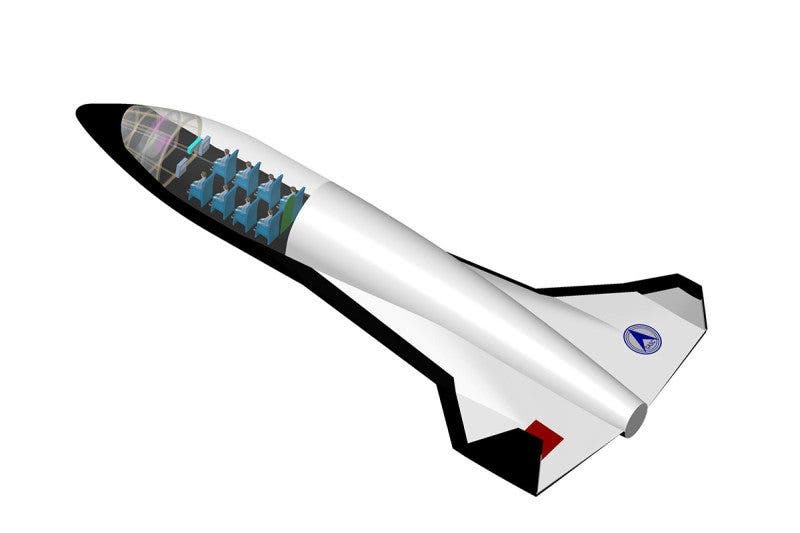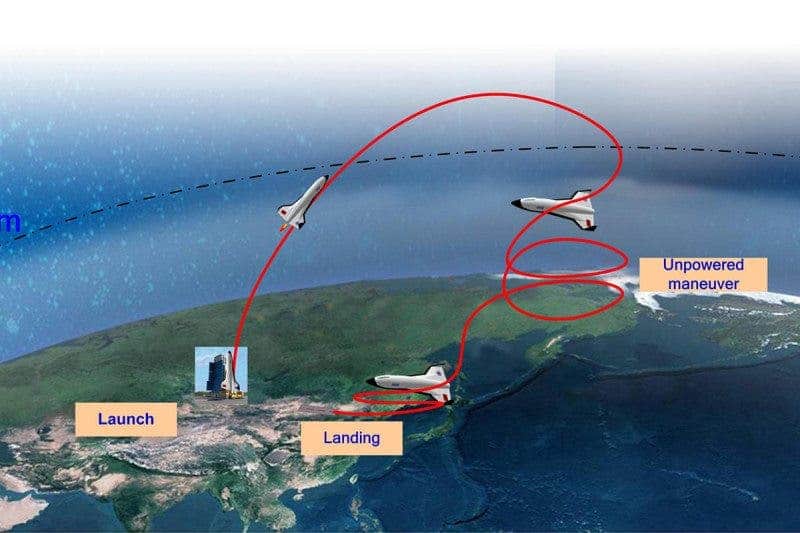
The shuttle-like spaceplane can carry 20 passengers above the Kármán line, where the aurora borealis forms. Credit: Pengxin Han / CALT
At the International Astronautical Congress in Guadalajara, Mexico, where last week Elon Musk famously laid out his plans to colonize Mars, there was another big announcement. Rocket scientist Lui Haiquang from China’s newly founded Academy of Launch Vehicle Technology dazzled the audience with technical drawings and a road map that will see the nation launch, what they call, the biggest spaceplane ever. One of the proposed designs involves a self-power rocket plane that will be capable of taking up to 20 people to the edge of space.
The most ambitious space tourism craft yet
Of course, right now there isn’t such a thing as a working spaceplane which is why announcements of this kind are met with skepticism. But though Haiquang’s keynote didn’t share Musk’s spotlight, if his team’s work is actually serious then space tourism might finally become commercially available.

China’s proposed craft will be re-usable and has a planned operational life of 50 flights. Credit: Pengxin Han / CALT
Right now, there are two big companies that are competing to be the first to make space tourism readily available. For one, there’s Blue Origin that has so far demonstrated a space capsule called New Shephard which can carry up to six persons. Last year, New Shephard became the first self-landing rocket, beating SpaceX’s Falcon by a couple of weeks. Then, there’s Virgin Galactic’s SpaceShipTwo which also ought to carry six people if the project is proven successful.
The Chinese spaceplane seems to defy its competitors with a shuttle-like craft that’s built to carry a lot more people to the edge of space. There are two designs on the drawing board right now. One 10-tonne version could carry up to five people to an altitude of 100 kilometers but the 100-tonne version is designed to carry twenty space enthusiasts to an altitude of 130 kilometers.
The winged rocket will supposedly take off vertically on its own with no additional rocket booster then land horizontally on an airstrip like any normal airplane.
The small version can fly to speeds up to Mach 6 offering its passengers roughly two minutes of weightlessness. The 100-tonne version can fly up to Mach 8 speed offering a four-minute weightless cruise. This behemoth version can also carry a satellite if needed, i.e. someone pays for it. Speaking of which, Haiquang said the price tag for a ride should be between $200,000 and $250,000.
A prototype has already passed ground tests, according to Haiquang, and test flights should be completed in the next two years. By 2020 the first payloads should be carried into space and if all goes according to plan, manned flights can commence.
But is this all just a paper spaceplane?
By now, some of you are excited but there are expert voices who are more reserved. Speaking to New Scientist, Roger Launius, who is a spaceflight expert at the Smithsonian Institution’s National Air and Space Museum in Washington DC, said:
“The most unusual part is the belief that they can send up to 20 people to 100 kilometres and more on a rocket without a mother ship and no staging, reusing it some 50 times,” he says. “It’s not explained how that will be accomplished. And the fact that they think they can test fly in the next 2 years is remarkable.”
“It is always easier to draw illustrations and talk possibilities than to build and fly spacecraft.
I also side with Launius on this one, though to be fair China has made tremendous progress in space flight in the last couple of years. In September, China launched its second space lab, Tiangong-2, into Earth’s orbit. Next is a probe destined for the dark side of the moon, a Mars rover slated for 2020, an advanced telescope that will dock with the upcoming Tiangong-3 and, finally, a manned mission to Mars by 2036.









